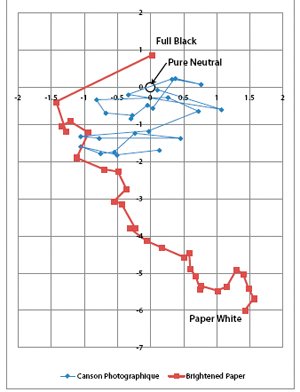articles/Printing/abw-page3
ABW - Fine Tuning Your Monochrome Output - part 3 of 1 2 3 4 5 6 7
by Mike McNamee Published 01/08/2012

You could be forgiven for thinking that measuring how white a piece of paper is were a trivial task. It is not! Note that we wrote the measurement technique up in the January 2012 issue.
Testing
Choosing the paper
We cast around for a paper to act as a solid baseline. Previous trials with brightened paper (Kirkland) were compromised by the difficulty of measurement - the spectro is fooled by the OBAs in Kirkland and the cool bias carries numbers that are larger than the ABW adjustments! Canson Baryta Photographique was the strongest contender. This is a baryta paper with no OBAs and a near neutral coating. It had audited well back in 2010 using an Epson 3800 but that printer is no longer with us and so we had to start again with the Epson 4900 and its high gamut ink set. We were not disappointed, the audit produced a set of statistics which as far as we can recall have never been bettered, so good indeed that we have given the media its own place in the sun after this feature!

The struggle to keep the greys under control with a brightened paper and the improvement from using the Canson paper is illustrated in the graph. Here the tone parameters (Lab a and b values) are plotted for greys right down the tone scale from white to black. The base tone of the brightened paper is moderately cool (-6 Lab b points) compared with some papers we have tested (we have measured as cool as -11 points) but you can see the tones tracking towards more neutral from white towards back.
By comparison the Canson results start near neutral and stay there, any variations are more statistical noise than any definite bias. The graph also illustrates the dilemma we have for these tests, a -6 value can be the result of 60 points in the ABW scale but this is just for the paper on its own.
Printing the tests
Having set the scene, we created real prints using matrix (ring around) of ABW settings. Previously we have done this test matrix on a single sheet of paper by passing it through the printer 10 times at different settings and printing each variant. This is no longer possible with the 4900 as it looks at the paper after the first pass, decides it has an image on it and spits it out! Scoping trials had suggested that 10 ABW points was a little indistinct and so we chose variants based on 20 units and 50 units in the ABW colour wheel. We also printed on the diagonal values of 50:50, 20:20 and all the negative values as well. It should be remembered that a 50 point variation in a single direction is smaller than one which uses 50:50 which is 1.4x larger (by Pythagoras - it's x v2). This showed both on screen and in the prints, ie the discrimination was sufficient at this level.
Please Note:
There is more than one page for this Article.
You are currently on page 3
- ABW - Fine Tuning Your Monochrome Output page 1
- ABW - Fine Tuning Your Monochrome Output page 2
- ABW - Fine Tuning Your Monochrome Output page 3
- ABW - Fine Tuning Your Monochrome Output page 4
- ABW - Fine Tuning Your Monochrome Output page 5
- ABW - Fine Tuning Your Monochrome Output page 6
- ABW - Fine Tuning Your Monochrome Output page 7
1st Published 01/08/2012
last update 21/07/2022 08:46:22
More Printing Articles
There are 21 days to get ready for The Society of Photographers Convention and Trade Show at The Novotel London West, Hammersmith ...
which starts on Wednesday 14th January 2026










